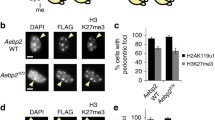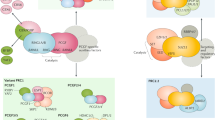Abstract
CRAMPED (CRM), conserved from plants to animals, was previously characterized genetically as a repressive factor involved in the formation of facultative and constitutive heterochromatin (Polycomb silencing, position effect variegation). We show that crm is dynamically regulated during replication and identify the Histone gene cluster (His-C) as a major CRM target. Surprisingly, CRM is specifically required for the expression of the Histone H1 gene, like the promoter-bound transcription factor TRF2. Consistently with this, CRM genetically interacts and co-immunoprecipitates with TRF2. However, the Polycomb phenotypes observed in crm mutants are not observed in TRF2 hypomorphic mutants, suggesting that they correspond to independent roles of CRM. CRM is thus a highly pleiotropic factor involved in both activation and repression.









Similar content being viewed by others
References
Ai HW, Shaner NC, Cheng Z, Tsien RY, Campbell RE (2007) Exploration of new chromophore structures leads to the identification of improved blue fluorescent proteins. Biochemistry 46:5904–5910
Bashirullah A, Lam G, Yin VP, Thummel CS (2007) dTrf2 is required for transcriptional and developmental responses to ecdysone during Drosophila metamorphosis. Dev Dyn 236:3173–3179
Birve A, Sengupta AK, Beuchle D, Larsson J, Kennison JA, Rasmuson-Lestander A, Muller J (2001) Su(z)12, a novel Drosophila Polycomb group gene that is conserved in vertebrates and plants. Development 128:3371–3379
Bischof J, Maeda RK, Hediger M, Karch F, Basler K (2007) An optimized transgenesis system for Drosophila using germ-line-specific {varphi}C31 integrases. Proc Natl Acad Sci USA 104:3312–3317
Boyer LA, Latek RR, Peterson CL (2004) The SANT domain: a unique histone-tail-binding module? Nat Rev Mol Cell Biol 5:158–163
Brand AH, Perrimon N (1993) Targeted gene expression as a means of altering cell fates and generating dominant phenotypes. Development 118:401–415
Ehsan H, Reichheld JP, Durfee T, Roe JL (2004) TOUSLED kinase activity oscillates during the cell cycle and interacts with chromatin regulators. Plant Physiol 134:1488–1499
Gambetta MC, Oktaba K, Muller J (2009) Essential role of the glycosyltransferase sxc/Ogt in polycomb repression. Science 325:93–96
Gibert JM, Karch F, Schlötterer C (2011) Segregating variation in the Polycomb group gene cramped alters the effect of temperature on multiple traits. PLoS Genet 7(1):e1001280
Gibert JM, Peronnet F, Schlotterer C (2007) Phenotypic plasticity in Drosophila pigmentation caused by temperature sensitivity of a chromatin regulator network. PLoS Genet 3:e30
Gildea JJ, Lopez R, Shearn A (2000) A screen for new trithorax group genes identified little imaginal discs, the Drosophila melanogaster homologue of human retinoblastoma binding protein 2. Genetics 156:645–663
Isogai Y, Keles S, Prestel M, Hochheimer A, Tjian R (2007) Transcription of histone gene cluster by differential core-promoter factors. Genes Dev 21:2936–2949
Klymenko T, Papp B, Fischle W, Kocher T, Schelder M, Fritsch C, Wild B, Wilm M, Muller J (2006) A Polycomb group protein complex with sequence-specific DNA-binding and selective methyl-lysine-binding activities. Genes Dev 20:1110–1122
Kopytova DV, Krasnov AN, Kopantceva MR, Nabirochkina EN, Nikolenko JV, Maksimenko O, Kurshakova MM, Lebedeva LA, Yerokhin MM, Simonova OB et al (2006) Two isoforms of Drosophila TRF2 are involved in embryonic development, premeiotic chromatin condensation, and proper differentiation of germ cells of both sexes. Mol Cell Biol 26:7492–7505
Levine SS, Weiss A, Erdjument-Bromage H, Shao Z, Tempst P, Kingston RE (2002) The core of the polycomb repressive complex is compositionally and functionally conserved in flies and humans. Mol Cell Biol 22:6070–6078
Liu JL, Murphy C, Buszczak M, Clatterbuck S, Goodman R, Gall JG (2006) The Drosophila melanogaster Cajal body. J Cell Biol 172:875–884
Lu X, Wontakal SN, Emelyanov AV, Morcillo P, Konev AY, Fyodorov DV, Skoultchi AI (2009) Linker histone H1 is essential for Drosophila development, the establishment of pericentric heterochromatin, and a normal polytene chromosome structure. Genes Dev 23:452–465
Nagai T, Ibata K, Park ES, Kubota M, Mikoshiba K, Miyawaki A (2002) A variant of yellow fluorescent protein with fast and efficient maturation for cell-biological applications. Nat Biotechnol 20:87–90
Nekrasov M, Wild B, Muller J (2005) Nucleosome binding and histone methyltransferase activity of Drosophila PRC2. EMBO Rep 6:348–353
Ner SS, Harrington MJ, Grigliatti TA (2002) A role for the Drosophila SU(VAR)3-9 protein in chromatin organization at the histone gene cluster and in suppression of position-effect variegation. Genetics 162:1763–1774
Pitulescu ME, Teichmann M, Luo L, Kessel M (2009) TIPT2 and geminin interact with basal transcription factors to synergize in transcriptional regulation. BMC Biochem 10:16
Rabenstein MD, Zhou S, Lis JT, Tjian R (1999) TATA box-binding protein (TBP)-related factor 2 (TRF2), a third member of the TBP family. Proc Natl Acad Sci USA 96:4791–4796
Rozenblatt-Rosen O, Rozovskaia T, Burakov D, Sedkov Y, Tillib S, Blechman J, Nakamura T, Croce CM, Mazo A, Canaani E (1998) The C-terminal SET domains of ALL-1 and TRITHORAX interact with the INI1 and SNR1 proteins, components of the SWI/SNF complex. Proc Natl Acad Sci USA 95:4152–4157
Salvaing J, Decoville M, Mouchel-Vielh E, Bussiere M, Daulny A, Boldyreva L, Zhimulev I, Locker D, Peronnet F (2006) Corto and DSP1 interact and bind to a maintenance element of the Scr Hox gene: understanding the role of Enhancers of trithorax and Polycomb. BMC Biol 4:9
Saurin AJ, Shao Z, Erdjument-Bromage H, Tempst P, Kingston RE (2001) A Drosophila Polycomb group complex includes Zeste and dTAFII proteins. Nature 412:655–660
Schuettengruber B, Cavalli G (2009) Recruitment of polycomb group complexes and their role in the dynamic regulation of cell fate choice. Development 136:3531–3542
Schuettengruber B, Ganapathi M, Leblanc B, Portoso M, Jaschek R, Tolhuis B, van Lohuizen M, Tanay A, Cavalli G (2009) Functional anatomy of polycomb and trithorax chromatin landscapes in Drosophila embryos. PLoS Biol 7:e13
Schwartz YB, Kahn TG, Nix DA, Li XY, Bourgon R, Biggin M, Pirrotta V (2006) Genome-wide analysis of Polycomb targets in Drosophila melanogaster. Nat Genet 38:700–705
Shaner NC, Campbell RE, Steinbach PA, Giepmans BN, Palmer AE, Tsien RY (2004) Improved monomeric red, orange and yellow fluorescent proteins derived from Discosoma sp. red fluorescent protein. Nat Biotechnol 22:1567–1572
Simon JA, Kingston RE (2009) Mechanisms of polycomb gene silencing: knowns and unknowns. Nat Rev Mol Cell Biol 10:697–708
Siriaco G, Deuring R, Chioda M, Becker PB, Tamkun JW (2009) Drosophila ISWI regulates the association of histone H1 with interphase chromosomes in vivo. Genetics 182:661–669
Spierer A, Begeot F, Spierer P, Delattre M (2008) SU(VAR)3-7 links heterochromatin and dosage compensation in Drosophila. PLoS Genet 4:e1000066
van Steensel B, Henikoff S (2000) Identification of in vivo DNA targets of chromatin proteins using tethered dam methyltransferase. Nat Biotechnol 18:424–428
Yamamoto Y, Girard F, Bello B, Affolter M, Gehring WJ (1997) The cramped gene of Drosophila is a member of the Polycomb-group, and interacts with mus209, the gene encoding Proliferating Cell Nuclear Antigen. Development 124:3385–3394
Acknowledgments
We would like to thank all members of the Spierer, Pauli and Karch laboratories for stimulating discussions, in particular, Rob Maeda. We thank the Bloomington Drosophila Stock Center for the TRF2 G0039 and H2Av–RFP lines, Joseph Gall for the UAS–DLsm11–Venus line, Walter Gehring for the anti-CRM antibody, Frédérique Peronnet for the anti-PCNA antibody, and Robert Tjian for the anti-TRF2 antibody. We thank Mylène Docquier and Didier Chollet for their assistance at the genomic platform, Geneva.
Author information
Authors and Affiliations
Corresponding author
Additional information
Communicated by R. Paro
Electronic supplementary material
Below is the link to the electronic supplementary material.
Supplementary Fig 1
Expression of mCherry-CRM and nuclear GFP under the control of HS-Gal4 in salivary glands (GIF 143 kb) In the absence of heat shock, a homogenous expression of nuclear GFP is observed, whereas mCherry–CRM level is higher in some nuclei.
Rights and permissions
About this article
Cite this article
Gibert, JM., Karch, F. The Polycomb group protein CRAMPED is involved with TRF2 in the activation of the histone H1 gene. Chromosoma 120, 297–307 (2011). https://doi.org/10.1007/s00412-011-0312-2
Received:
Revised:
Accepted:
Published:
Issue Date:
DOI: https://doi.org/10.1007/s00412-011-0312-2




